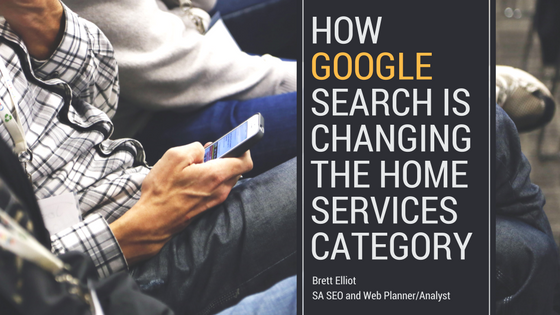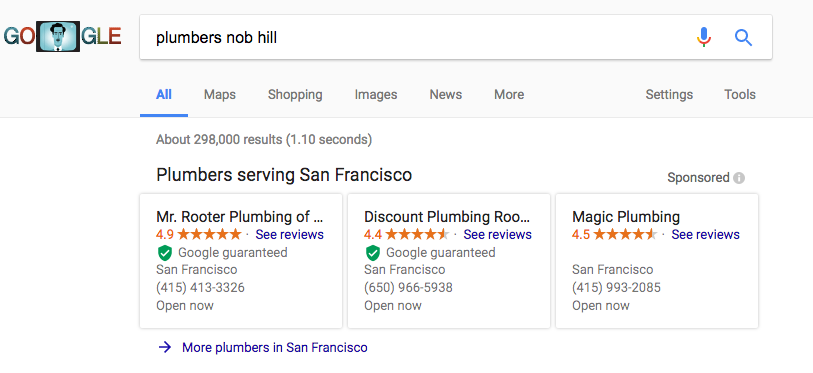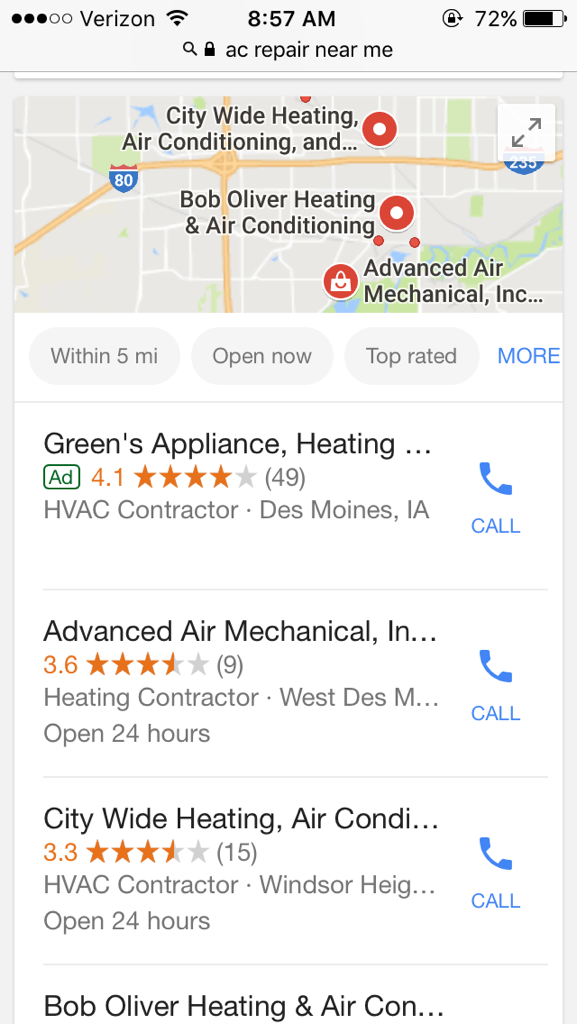
How Google is Changing the Home Services Category
All good things must come to an end. For SEOs, this means that we’re constantly reinventing the wheel, studying Google and developing new strategies. Usually, it also means that the once easier and free method has become less easy and less free. For those of us in the home services category (or with clients in the home services category), things are changing again. Cue Bob Dylan.
In the next few paragraphs I’ll explain how Google is increasing relevant, above-the-fold ads, and why this will likely snag some of our organic clicks.
Local businesses in the home services category have benefitted greatly from Google’s updates to the local algorithm, which has provided more relevant search results to users. After all, I need a plumber nearby, not 500 miles away. By doing some simple optimization, we could generally rank on page one in this category using basic to intermediate SEO tactics, completely eschewing backlinks in many cases since Google favors relevancy over authority for these types of searches.
When we look at searcher intent and map it to keywords, most SEOs agree with how to group these searches, starting with informational type searches and ending with a transactional search. That’s not to say that a searcher’s lifecycle is ever this basic or straightforward, but in general, this simple model is highly applicable to the consumer journey a homeowner goes through when searching for home services.
Most of us focus on head terms with a geo-modifier appended to it. This would be something like “plumbing repair Portland, Oregon.” This is a highly transactional search. These consumers are in a hurry, responding to an emergency, or completely skipping or only briefly skimming the research/informational phase. If it’s 105 degrees outside and the A/C has just gone out, or your teenager has just put a dent in the garage door and it won’t shut all the way, or if you have a severe leak and there aren’t enough buckets, you’re likely on a shorter timeline and need to get someone out to your house about five minutes ago. These are customers we target in local search—the people who require minimal time to evaluate a company to determine if they can be trusted and if they are available.
We also call these consumers money users—the people who are in desperate need. If the company can respond to their emergency quickly, these consumers become brand advocates, are likely to give good reviews and become repeat customers with very little nurturing. Best of all, they are often new to your brand. Their value cannot be overstated. Enter Google’s Home Service Ads.
These ads deliver highly relevant results for the user in a hurry. They have great reviews and are backed by the Google guarantee, which means they’re low risk and will guarantee a company’s work up to $2,000. They also have higher visibility than anything else on the page. These ads typically appear for those highly transactional queries that our client’s sites target. This is almost certainly guaranteed to cannibalize some of our most valuable customers in the home services category, making the search engine results page more pay to play than ever before.
On top of that, Google has been testing ads in the map pack since June of 2016, and local SEOs have let it fly under the radar. Feast your eyes.
This is not the death of (local) SEO. But, it does mean we need to pivot and adopt a new strategy. SEOs must target users who are at different stages of the consumer journey and create content to draw people into the funnel earlier as opposed to targeting at the transactional stage. How do we do this?
Since we know Google is targeting highly commercial queries, we need to adjust our strategy to capture folks at the research stage. If someone types in “how do I tell when I need a new roof,” you want to be there first. Maybe you have a blog post that informs users how to tell if they need a new roof and you’re ranking in the top three. Great! Now what?
Traditionally, as SEOs, we bring in the leads and let the web developers and designers handle the rest. There could be lots of reasons for this, but expanding your role and taking a more holistic approach should be a priority. You won’t capture any leads at this stage without building a funnel. That user who just landed on your page self-identified as someone who is concerned about their roof! Don’t give them a piece of content and watch them leave and run another search on Google for “best roofers near me.” You built this page with the knowledge of the consumer’s state of mind and where they fall in the journey, so you need to provide insight on what the next step will be. The person on the other end of the internet searching that page has a “next step” that might include:
- Gather more information
- Call a professional
- Attempt to fix it themselves
Maybe add a CTA for a free roof evaluation. You could add links to other relevant topics around your blog. You could create a DIY guide for some common fixes or easy troubleshooting and lock it down so interested readers must enter an email to download it. Once you have their email, add them to a drip campaign and offer other helpful content. Is in-person upselling a part of your company’s marketing plan? Offer to send out a roofer to check on things, free of charge. Maybe you’re a small company and take a personalized approach. Send a personal email! Ask them how they’re doing and if there are any questions they can answer about your roof. How you choose to run your nurture program is up to you, but know that it can be low-cost and effective.
Yes, the SEO game has become harder, more intensive and more expensive than ever before. Adapt. Be agile. Google search is changing and so should we.





